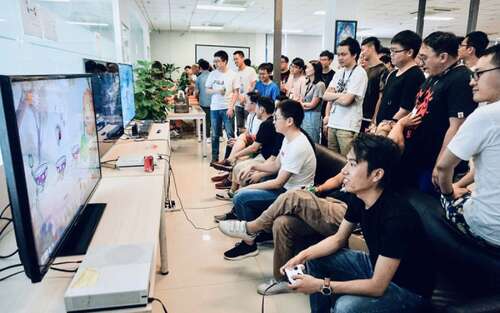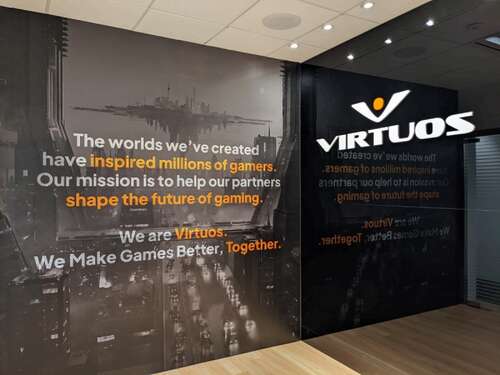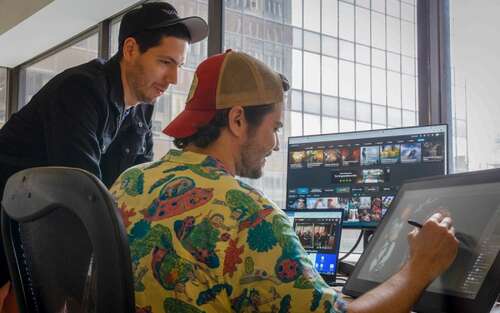Virtuos has carved out a big business since 2004 as a company that handles outsourced game development for both developers and publishers. With more than 3,700 people around the world, it has grown into co-development roles with major game companies.
That gives Gilles Langourieux, CEO of Virtuos, a bird’s-eye view of the game industry, which has been in a difficult state in the past year. While AI is booming and the U.S. economy has avoided a recession, game companies have been laying off thousands of game developers. More than 6,000 people have lost their jobs this year, and more than 10,500 were laid off last year, according to Game Layoff Tracker.
Game industry revenues were $184.0 billion in 2023, growing a mere 0.6% from a year earlier, according to market researcher Newzoo. The meager growth was preceded by a 5% drop in 2022, 1.4% growth in 2021 and 9.3% growth in 2020. So why is the game industry seem so out of sync with the rest of tech and the global economy?
Singapore-based Virtuos has been one of the giants of co-development, where the company employs game developers around the world to assist publishers and game studios that need help finishing their games during a large production. As such, it gets a window into the changes at lots of game companies.
GB Event
GamesBeat Summit Call for Speakers
We’re thrilled to open our call for speakers to our flagship event, GamesBeat Summit 2024 hosted in Los Angeles, where we will explore the theme of “Resilience and Adaption”.
The company started in China in 2004 with a studio in Shanghai. It expanded to other cities like Chengdu and Xian. Then it acquired Sparx in 2011 and moved out of China to relocate its headquarters to Singapore in 2018. Langourieux’s company has worked on well over 1,000 projects for the top digital entertainment companies across the world. Let’s see what he has to say.
Here’s an edited transcript of our interview.

GamesBeat: What do you see in the gaming business?
Gilles Langourieux: The risk reduction continues. Cutting projects that seem to have a less certain outcome. Reducing costs when money was more expensive. You’ve covered that very well already. That’s continuing. We still see some projects being reduced. But if I look at the quarterly numbers in 2023, we had quarters that were difficult in Q1 and Q2. Q3 was stronger than Q2 and Q4 was stronger than Q3, and also than the previous year’s Q4. Nothing dramatic, but there is definitely a progression.
For us, the flight to safety, the risk reduction, has translated into the business of our studios in the west growing very significantly, 30% growth compared to the year before. But business for the studios in Asia has contracted a bit, a 10% reduction. It’s a good demonstration of what’s going on in the minds of some of our clients. They feel that in a world of risk, you want to work with people closer to you. You consider working with people who are far away as more difficult or higher in risk.
GamesBeat: What was interesting is that maybe this time around, for this downturn, compared to any previous downturn, there’s a much bigger layer of people working in the industry where you are. The outsourcing companies have never seemed so large. You have, I think, 3,500 people?
Langourieux: We’ve been stable at 3,700.
GamesBeat: And Keywords is well over 10,000. These kinds of companies have never been so large in previous downturns.
Langourieux: You could argue that some of them have become so large because they acquired companies that already existed. The optics might be misleading. But if we look at the bigger picture, we have about 300,000 to 400,000 people working in the game industry worldwide. Turnover in the industry has been about 15% on average. You probably have 50,000 to 60,000 people who change jobs every year. That’s a conservative estimate. I think it’s a bit low. We had an additional 10,000 last year because of jobs lost. That’s not great. But it’s not an order of magnitude. It doesn’t change the magnitude of job changes in the industry.

The way we were making games has to mature a bit. We’ve been relying too much on fixed teams. We need more flexibility. We all know that there’s a peak in production, and then after that peak you need fewer people. If you’re trying to develop games with fixed teams only, you have that vicious cycle of hiring a lot of people and then letting them go when you’re under cost pressure. That can change if you leverage external development more. Our job is to provide that flexibility. When one project finishes at Virtuos, we have other projects that can occupy our people. You can have more stability on the client side, while on our end we’re also working to provide more stability.
The point is, we didn’t have enough flexibility in the way we were developing games before. A company like Virtuos, one of our main reasons for existing is to provide both quality and flexibility to our clients, so that everyone’s jobs are more stable. You have smaller core teams that are more stable on the customer side, and then we also maintain stability by being able to transition people from one project to another, one client to another. That’s more healthy than what we had before large companies like us existed, in my view.
GamesBeat: Does it feel like, in this layer of the industry, there are a lot more people working here among the outsourcing companies?
Langourieux: I think so, yes. If you compare today to 10 years ago, there’s probably a larger percentage of people working at companies like ours, external development companies. You also had a lot of smaller independent studios. There has been a consolidation with a lot of those studios being acquired. The big publishers made a lot of acquisitions to consolidate their development workforce. Has the proportion between external and internal changed that much, though? I don’t have data on that. But I would agree with you that there are more, larger, and stronger external developers like us around. I think that’s a good thing, because we can bring the flexibility that was missing before.
GamesBeat: Would you agree that the layoffs we saw beginning in 2023 are bigger than what normally happens in a year? Amir Satvat’s estimate that there were maybe four or five times as many layoffs happening in 2023 compared to what he considered a normal year. We did have some abnormal years leading up to that, with so much hiring going on. But if a larger number of layoffs happened in 2023, and continuing here in 2023, what do you think the reason is?

Langourieux: I don’t doubt the numbers that have been circulated. They do look higher than previous years. There has always been a significant volume of turnover in the industry, though. We’re painting a picture that I think is a bit too bleak. By doing that we risk creating a business atmosphere that misses the opportunities and positives in the industry. Yes, those 10,000 people are in a more difficult position this year, and we need to figure out a way to help them. But every year there are 50,000 to 60,000 job changes. That presents a lot of opportunities as well for all of us.
I wouldn’t focus too much on the bleak side of it. We have a business in 2024 which is maybe twice as big as what it was five years ago. A lot of players to serve, a lot of opportunities to find jobs for everyone, including those who were recently laid off. Nobody is counting all the jobs that are open at all these game companies.
GamesBeat: There’s the notion of creative destruction. There are winners and losers, and the losers may lay people off, but the winners are more quietly hiring a lot of people. It happens every year.
Langourieux: You remind me of an interesting data point I saw a couple of weeks ago. We looked at the revenue progression in the first half of 2023 for the top 25 listed game companies. In the top 25, the top 13 had a 17% increase in revenue for the first half of the year. That was a big jump, and mainly thanks to Warner and Harry Potter, but even without that, the top 12-13 had a big progression. But the lower half of the top 25 had a 10% drop on average.
It’s a simplified illustration of what’s happened with the more solid IPs, the more solid players, figuring out a way to consolidate. Some of the weaker IPs and players are finding more difficulty in keeping the attention of gamers. When I look at my business, I see the same thing. I see cancellations of projects that were on the weaker side, while there’s stable business demand coming in from projects and IP on the stronger side. That’s quite consistent.
GamesBeat: Is there still a pandemic effect going on, where we had lots of hiring to support companies that had less productivity due to remote work? A lot of growth happened, lots of hiring, and then when people went back outside they didn’t have as much time to dedicate to games, leading to a weaker year. Maybe we had over-hired during the pandemic before revenue reverted back to that of more normal years.
Langourieux: I visited 40 studios in the last two months of last year, 40 of our clients on three continents. I couldn’t obtain a consensus on how the hybrid model was affecting productivity. One day I would visit a studio where they were all remote and they felt everything was fine. They’d just shipped a fantastic game and everything was going well. The next day I’d visit another studio where they complained that their productivity was down because of the hybrid model. No consensus on that topic.
Where there was a consensus was on the need to go where the players are. Players, consumers, have moved around a bit in their interests before, during, and after the pandemic. The push for covering more platforms, following new platforms like Netflix, offering more culturalized content, to really go where the players are, that’s where I saw consensus. Another consensus I saw was around the need for more flexibility. Revisiting the game development chain, if you like. But on productivity, no consensus.

GamesBeat: Another thing I wonder about, I’d heard more than once that there were too many good games. I think it was Axios that looked back at the last 20 years, and they found more higher-rated games in 2023 than in the previous 20 years. I hear complaints that there was just too crowded a schedule for great games. Something like Armored Core 6 came out in August only to run into the launch of Starfield a couple of weeks later. Do you think that explains why we had so many highly rated games, and yet stagnant sales?
Langourieux: After you’ve had such high growth in 2021 and 2022, some stagnation is not the end of the world. The studios shipping those great games, I don’t think they’re the studios where you have the biggest layoffs. You have layoffs at studios that haven’t shipped great games. I’m never going to complain about working on too many great games, having too many great games on the market. We should be proud of that. We shouldn’t worry about that. We should be maybe a bit more worried about the fact that players may be migrating to other forms of digital entertainment. Ensuring that we have great games and renewed content to bring them back, to keep them with us, that should be our focus.
When you see the hard work paying off, like Avalanche making a fantastic Harry Potter game, or From Software making their fantastic complex games, or the hard work at Epic keeping Fortnite relevant so many years after release – injecting Lego, injecting Metal Gear – to go where the players are, that’s very encouraging.
GamesBeat: How does the outlook for 2024 seem to you?
Langourieux: We have two uncertainties. The level of activity in the first quarter of this year is comparable to the last quarter of last year. No major drop, no fast growth yet. There are still some uncertainties. What we’re doing on our end are three things. We’re working to continue to localize the company. What I mean by that is we want to be global with local studios. We’ve invested in a new studio in Japan, a new studio in Prague, so that we have a bigger global presence. We’re also investing in raising the level of sophistication and complexity – creativity, if you like – in what our talent is able to do. We’re investing a lot in technology, embracing new technologies and developing some things of our own to bring new solutions to our clients. When the market picks up again, we want to be ready with a more global, more creative, more technically advanced business.
GamesBeat: I take it that the external development industry didn’t have as many layoffs as we saw from the big publishers last year.
Langourieux: Our companies are less public. It’s difficult to find reliable information. When I look at LinkedIn, I see that about half of our competitors have a higher number of people listed than they did at the beginning of the year, and about half have fewer people. I think we’re not immune. We’re in the same boat as everyone. We finished the year with slightly more people, but after doing some small cuts in areas where we had very low occupation.
GamesBeat: I read Matthew Ball’s very long story about the game industry, and he had one observation I thought about. Game prices have generally been capped at the $60 or $70 mark, but we’ve seen strong inflation in costs over the last couple of years that maybe put pressure on. Some games in development wound up costing a lot more, but they couldn’t raise prices. The profits associated with those games were lower. How big a problem do you think that is? Do you think the industry is doing a good job attacking costs?
Langourieux: I have two points on this one. First of all, I think the industry does a fantastic job at making its pricing more flexible. If you compare how someone can purchase games at a different price point today, relative to what we had 15 or 20 years ago, it’s night and day. Before, you had no choice. You bought the box at a certain point and that was it. Maybe you could wait for a secondhand copy. Today we have so many price points. It runs from paying nothing to play for very long hours, or paying hundreds of dollars a month to have a supercharged experience. That’s good for the industry because it allows us to cover a wider spread of gamers and offer them lots of alternatives.
On the cost side, I told you at the beginning of this discussion that the biggest source of waste is fixed costs. It’s that lack of flexibility. It’s not realistic to work only with a fixed cost model. All other industries have figured out models that are more flexible, with smaller core creative teams. They’re able to ramp up and down, leveraging the flexibility of various providers. The supply chain in our case, the game development chain, is where we have some improvements to make if we want to ensure profitability for most actors.

GamesBeat: There’s more impact from AI recently. What do you think that impact is going to be in the future?
Langourieux: Games will always be made by humans, human creators. One of the first areas where AI seems to work is 2D art creation. We do see how 2D artists can quickly obtain more variations, more inspiration, more reference by leveraging AI. That’s great. I don’t for an instant think that in the long run, we’ll be needing fewer artists. We have to train artists to make the best of these new technologies, to remain relevant and remain competitive. But I’m absolutely convinced that games will continue to be made by humans.
The investments we’re making are in that direction. We’re having our artists experiment with anything new that’s coming, including AI. We’ve put training programs in place to ensure that we can upskill them to handle more creative tasks and carry out less of the grunt work, if the grunt work gets done by AI.
I can tell you a story about something that impressed me a lot. I visited one of our studios in Vietnam a couple of weeks ago. They pulled me aside to one artist who was using Copilot to create scripts to check the quality of his models. Someone who had never coded was suddenly empowered to very quickly create his own tools to clean up his models. I thought that was an interesting illustration of how AI can empower someone to do less of the boring stuff and more of the interesting stuff. He was very proud of being able to do this by himself, and he was happy with the way this affected his ability to work faster and deliver higher quality.
GamesBeat: If you could look in the crystal ball and figure out which quarter should be a better one for the industry, do you see that coming ahead?
Langourieux: It will happen this year, for sure. There were a lot of companies waiting to get budgets approved or confirmed to go into production. There are a lot of games that are in preproduction. We’re seeing these games start production in Q2 and Q3. The accumulation of these games entering production should turn into growth and activity in the industry.
I talk about activity because what I look at is how many people are working at my company and other companies producing games. Will there be extra revenue on the consumer side? I don’t know. Will we see more activity on the development side as these games go into production? Yes, I think so.
What’s had the biggest effect is the evolution of technology and computing power available to us. The arrival of new hardware and technology makes a big impact in the long term. It affects more game developers and publishers than any one game. There are two sides to AI. One, how does it make game development easier, but also, what kind of new gameplay can it bring to the table? A combination of new hardware coming along and new gameplay enabled by AI, making worlds more diverse, more challenging, and more interesting, that could be very powerful. I’m more looking forward to the first couple of games that leverage AI in a positive way, to make games more immersive and surprising.
The industry has always been driven by the evolution of technology. There’s no reason why we wouldn’t have a new injection in 2024 or 2025 after a couple of years of a relative lull or consolidation. If you look through a three-year lens instead of a one-year lens, suddenly the world looks great.

GamesBeat: Do you have advice for people working in the industry around how they can focus on career development?
Langourieux: First of all, put the noise into perspective. Don’t get discouraged by the noise. I don’t think we should be talking that much about job cuts, because there are still a lot of jobs to fill out there at all the major companies. Put forward your best work. Demonstrate how you have hope that games can continue to improve, that offering new content can bring players back. You’ll find a home. There are still a lot of jobs out there.
GamesBeat: Are there particular markets around the world you’re excited about? Any places that are starting to pick up more games than others?
Langourieux: I don’t know the Middle East very well, but it’s encouraging to see the number of new publishers and studios there. We had no clients from that part of the world five years ago, and we have a couple now. That’s encouraging. We’re headquartered in Singapore, and that Asian region is very dynamic. Thailand, the Philippines, Indonesia, India, these are fast-growing markets. They’re very exciting as well.
We’re celebrating our 20th anniversary at the end of 2024. One thing is for sure. The market that we’re operating in is bigger, more international, and more vibrant than it was one when we started.
VentureBeat’s mission is to be a digital town square for technical decision-makers to gain knowledge about transformative enterprise technology and transact. Discover our Briefings.

